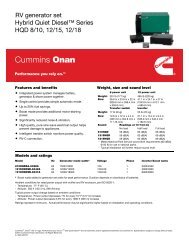Air Brake Manual
Air Brake Manual
Air Brake Manual
You also want an ePaper? Increase the reach of your titles
YUMPU automatically turns print PDFs into web optimized ePapers that Google loves.
Tandem Rear Axles<br />
34<br />
33 13<br />
The air brake system discussed previously is for a<br />
vehicle with a single rear axle. The diagram illustrates<br />
an air brake system for a vehicle equipped with an<br />
automatic front brake limiting valve (34), a quick<br />
release valve (33) and a tandem set of rear axles.<br />
Both axles of the tandem set are equipped with<br />
brakes.<br />
A relay valve (13) has two uses: to provide a quicker<br />
application of air pressure to the tandem rear axle<br />
brakes when a brake application is made, and to<br />
release the brakes quicker when a brake application<br />
is released.<br />
Section Summary Questions<br />
1. How can the driver tell how much air pressure<br />
is<br />
in the main reservoirs<br />
2. What must the driver do when a low pressure<br />
warning system activates<br />
3. What is the purpose of a quick release valve<br />
4. What is the purpose of a relay valve<br />
5. What is the purpose of using a larger diameter<br />
pipe between the reservoir and the relay valve<br />
6. If the front brake limiting valve is in the “slippery<br />
road” position, and the foot valve is depressed<br />
to make a brake application of 30 psi, how much<br />
pressure will be applied in the front brake<br />
chambers<br />
7. How is the reservoir protected from over<br />
pressurization<br />
8. What stops pressurized air from flowing from<br />
the dry reservoir back into the compressor<br />
9. At what pressure should the low pressure<br />
warning device activate<br />
10. How is “brake lag” to the rear wheels<br />
minimized<br />
11. When should a driver use the front brake<br />
limiting valve<br />
30




